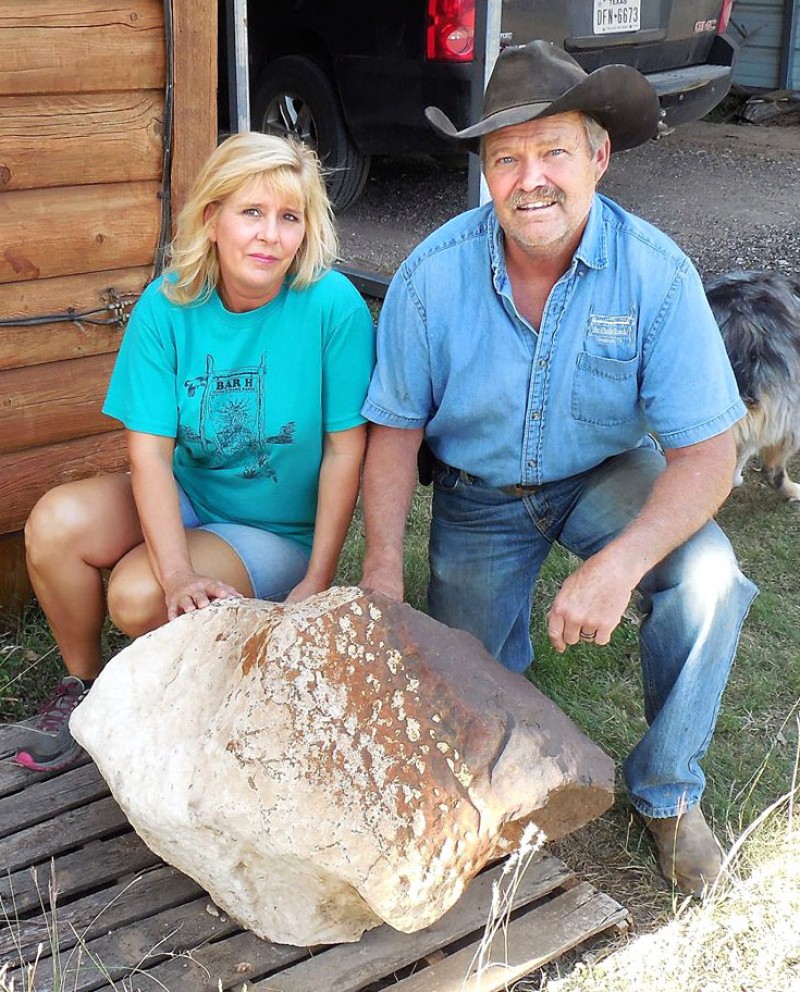 |
|
DeeDee and Frank Hommel pose with the 760 pound (345 kilogram) Clarendon (c) meteorite discovered on their land. The stony meteorite may be the second largest single chondrite ever found in the United States. It displays dark fusion crust on the topside; the bottom side, which faced down in the soil, is covered with caliche (ka-LEE-chee), a cement-like mineral deposit of calcium carbonate. Credit: Ruben Garcia, Univers Today
|
On April 6, 2015, Frank Hommel was leading a group of guests at his Bar H Working Dude Ranch on a horseback ride. The horses got thirsty, so Hommel and crew rode cross-country in search of a watering hole. Along the way, his horse Samson suddenly stopped and refused to go any further. Ahead of them was a rock sticking out of the sandy soil. Hommel had never seen his horse act this way before, so he dismounted to get a closer look at the red, dimpled mass. Something inside told him this strange, out of place boulder had to be a meteorite.
Here’s the crazy thing — Hommel’s hunch was correct. Lots of people pick up an odd rock now and then they think might be a meteorite, but in nearly every case it isn’t. Meteorites are exceedingly rare, so you’re chances of happening across one are remote. But this time horse and man got it right.
The rock that stopped Samson that April day was the real deal and would soon be classified and named the Clarendon (c) stony meteorite. Only the top third of the mass broke the surface; there was a lot more beneath the soil. Hommel used a tractor to free the beast and tow it to his home. Later, when he and his wife DeeDee got it weighed on the feed store scale, the rock registered a whopping 760 pounds (345 kilograms). Hommel with others returned to the site and recovered an additional 70 pounds (32 kilograms) of loose fragments scattered about the area.
At this point, Frank and DeeDee couldn’t be certain it was a meteorite. Yes, it attracted a magnet, a good sign, but the attraction was weak. Frank had his doubts. To prove one way or another whether this rusty boulder came from space or belonged to the Earth, DeeDee sent a photo of it to Eric Twelker of Juneau, Alaska, a meteorite seller who maintains the Meteorite Market website. Twelker thought it looked promising and wrote back saying so. Six months later, the family sent him a sample which he arranged to have tested by Dr. Tony Irving at the University of Washington.
Irving’s analysis revealed bright grains of iron-nickel metal and an abundance of chondrules, round grains composed of minerals that were flash-heated into a “fiery rain” in the solar nebula 4.5 billion years ago. When they cooled, the melted material congealed into small solid spheres several millimeters across that were later incorporated into the planetary embryos that grew into today’s planets and asteroids. Finding iron-nickel and chondrules proved beyond a shadow that the Hommels’ rock was a genuine stone from space.
 |
| Barred olivine chondrule in a meteorite in Arizona, mostly all olivine shell. U of Ariz. photo. |
In an e-mail communication, Twelker recounted his part of the story:
“I get about six to a dozen inquiries on rocks every day. I try to answer all of them — and give a rock ID if possible. I have to say my patience gets tried sometimes after looking at slag, basalt, and limestone day after day. But if I am in the right mood, then it is fun. This one made it fun. Over the years, I’ve probably had a half dozen discoveries this way, but this is by far the most exciting.”
Irving pigeonholed it as an L4 chondrite meteorite. L stands for low-iron and chondrite indicates it still retains its ancient texture of chondrules that have been little altered since their formation. No one knows how long the meteorite has sat there, but the weathering of its surface would seem to indicate for a long time. That said, Hommel had been this way before and never noticed the rock. It’s possible that wind gradually removed the loosely-bound upper soil layer — a process called deflation — gradually exposing the meteorite to view over time.
Once a meteorite has been analyzed and classification, the information is published in the Meteorite Bulletin along with a chemical analysis and circumstances of its discovery. Meteorites are typically named after the nearest town or prominent geographical feature where they’re discovered or seen to fall. Because it was found on the outskirts of Clarendon, Texas, the Hommels’ meteorite took the town’s name. The little “c” in parentheses after the name indicates it’s the third unique meteorite found in the Clarendon area. Clarendon (b) turned up in 1981 and Clarendon (a) in 1979. Both are H5 (high metal) unrelated stony chondrites.
Read more: Universe Today